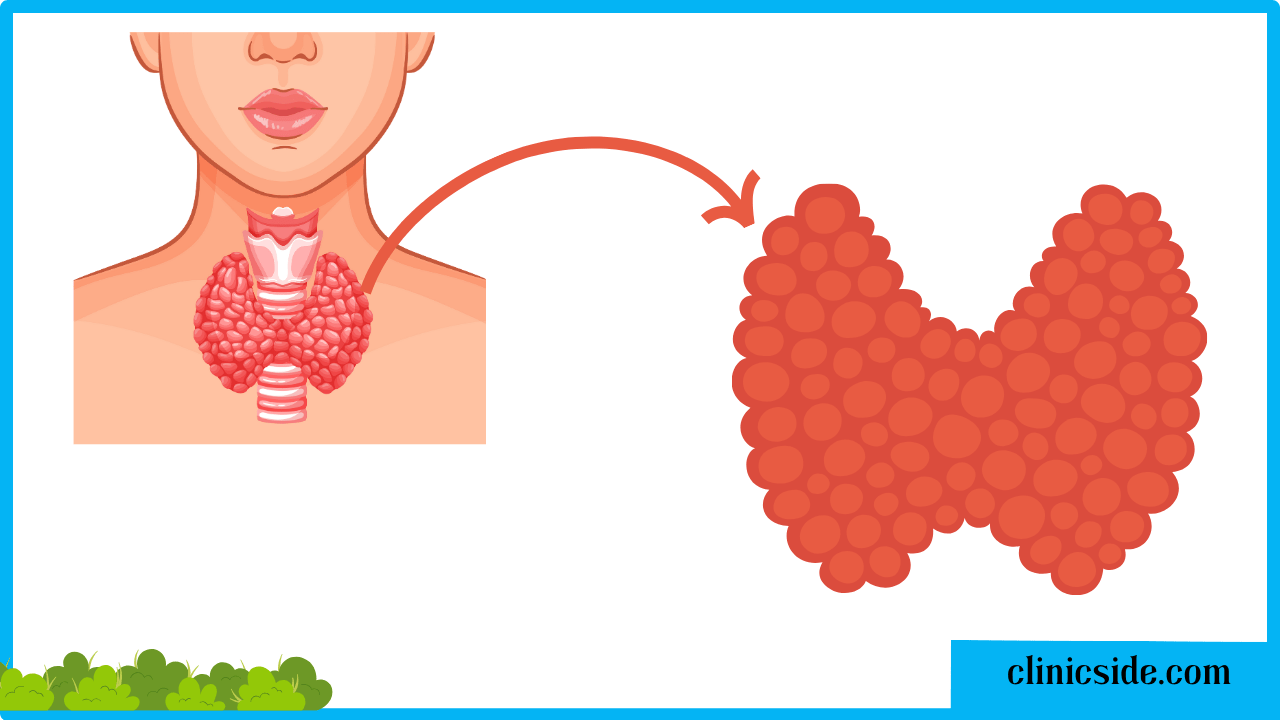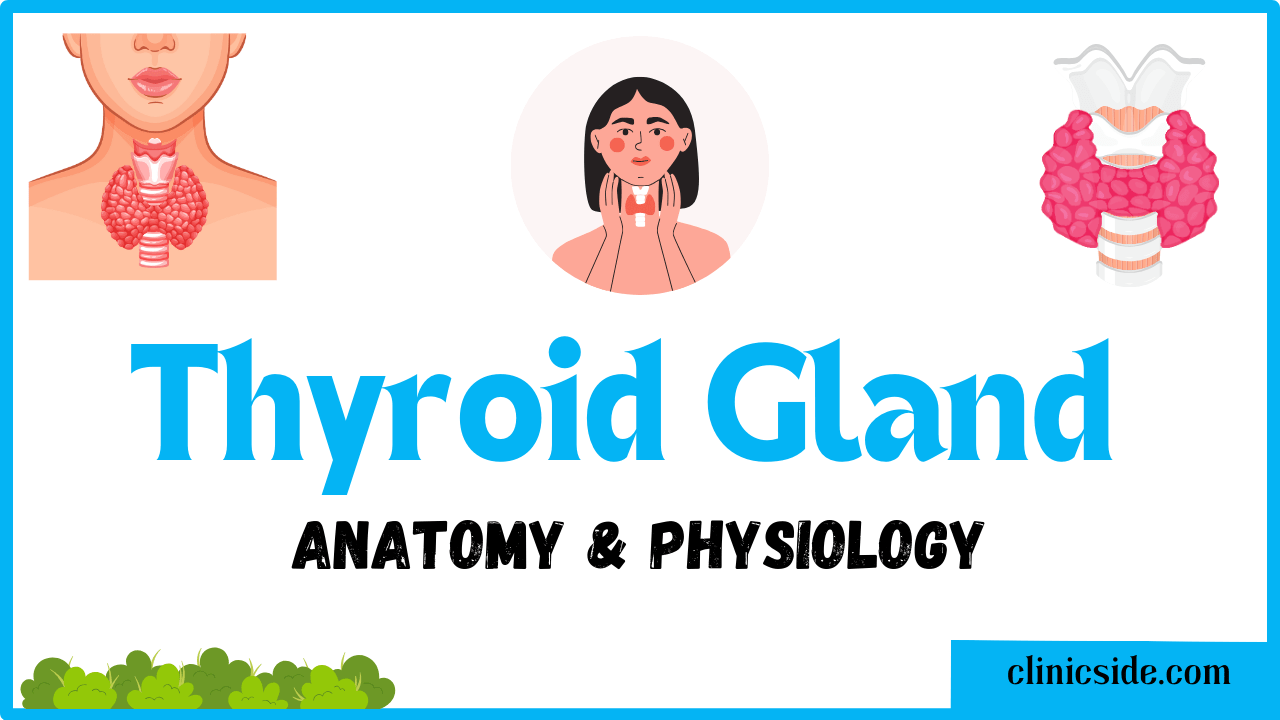Thyroid Gland: A Vital Endocrine Organ
The thyroid gland is a butterfly-shaped endocrine organ located in the front of the neck, just below the Adam’s apple.
This gland regulates several physiological processes in the body through hormone release.
Location and Structure:
- The thyroid gland is located in the anterior (front) part of the neck, straddling the trachea.
- It consists of two lobes, right and left, connected by a narrow band of tissue called the isthmus.
- The gland is positioned just above the collarbones and below the thyroid cartilage of the larynx.
Shape:
- The thyroid gland has a distinctive butterfly or H-shaped structure, with each lobe resembling a wing as shown in the figure below.
- The lobes curve around the sides of the trachea, meeting at the isthmus in the middle.

Anatomy of the Thyroid Gland:
- The thyroid gland consists of two lobes connected by a narrow isthmus, and it is composed of numerous follicles.
- These follicles contain a protein-rich colloid and are surrounded by thyroid cells responsible for hormone synthesis.
Histology and Components:
Follicles:
- The thyroid gland is composed of functional units called follicles.
- Follicles are spherical structures surrounded by thyroid cells and filled with a protein-rich substance called colloid.
- The colloid contains the precursor molecules necessary for the synthesis of thyroid hormones.
Thyroid Cells:
- The thyroid gland consists of two main types of cells: follicular cells and parafollicular cells (C cells).
- Follicular cells are responsible for synthesizing and secreting thyroid hormones.
- Parafollicular cells produce the hormone calcitonin, which is involved in calcium homeostasis.
Blood Supply and Nerve Innervation:
Blood Supply:
- The thyroid gland is highly vascularized, receiving an abundant blood supply.
- Two main arteries, the superior thyroid artery and the inferior thyroid artery, provide blood to the thyroid.
Nerve Innervation:
- The thyroid gland is innervated by branches of the sympathetic and parasympathetic nervous systems.
- Nerves help regulate blood flow to the gland and influence hormone release.
Thyroid Gland Function: Regulating Metabolism and Beyond

Thyroid Hormones Synthesis:
- The primary function of the thyroid gland is the synthesis of two crucial hormones: thyroxine (T4) and triiodothyronine (T3).
- These hormones are produced by the follicular cells within the thyroid gland.
- The synthesis process involves the incorporation of iodine into the amino acid tyrosine, forming T3 and T4.
Metabolic Regulation:
- Thyroid hormones play a central role in regulating metabolism, influencing the rate at which cells convert nutrients into energy.
- T3 is the more biologically active form and has a more direct impact on cellular metabolism.
Energy Balance:
- The thyroid gland contributes to the body’s energy balance by influencing the breakdown of carbohydrates, fats, and proteins.
- Increased thyroid hormone levels lead to enhanced energy production and heat generation.
Body Temperature Regulation:
- Thyroid hormones help regulate body temperature by influencing the metabolic rate.
- Elevated levels of thyroid hormones increase heat production, contributing to thermoregulation.
Growth and Development:
- Thyroid hormones are critical for normal growth and development, especially in children and during fetal development.
- They play a key role in the maturation of the nervous system, bones, and other organs.
Cardiovascular Effects:
- Thyroid hormones have significant effects on the cardiovascular system.
- They influence heart rate, cardiac output, and blood pressure, contributing to overall cardiovascular homeostasis.
Protein Synthesis and Breakdown:
- Thyroid hormones affect protein synthesis and breakdown in various tissues.
- They influence the balance between anabolism and catabolism, contributing to tissue maintenance and repair.
Calcium Homeostasis:
- The parafollicular cells (C cells) within the thyroid gland produce calcitonin, a hormone involved in calcium homeostasis.
- Calcitonin helps regulate blood calcium levels by inhibiting bone resorption and promoting calcium excretion by the kidneys.
Brain Function:
- Thyroid hormones are essential for normal brain development and function.
- They play a crucial role in cognitive function, mood regulation, and overall mental well-being.
Feedback Loop Regulation:
- The secretion of thyroid hormones is tightly regulated by a feedback loop involving the hypothalamus, pituitary gland, and thyroid gland.
- Elevated thyroid hormone levels inhibit the release of thyrotropin-releasing hormone (TRH) and thyroid-stimulating hormone (TSH), maintaining a delicate balance.
Thyroid Gland Hormones: Synthesis, Mechanism of Action, and Hormonal Imbalances
Thyroid Hormones: Overview
The thyroid gland is responsible for the production of two primary hormones, thyroxine (T4) and triiodothyronine (T3). These hormones play a crucial role in regulating the body’s metabolism.
Synthesis of Thyroid Hormones
Iodine Uptake: The thyroid gland actively takes up iodine from the bloodstream.
Follicular Cells: Thyroid hormones are synthesized within follicular cells using iodine and the amino acid tyrosine.
Colloid: Follicles store a gel-like substance called colloid, which contains the precursor molecules for hormone synthesis.
Mechanism of Action
Transport in Blood: T4 and T3 are released into the bloodstream and carried by transport proteins.
Peripheral Conversion: T4 is converted to the more biologically active T3 in peripheral tissues (liver, kidneys, etc.).
Cellular Uptake: T3 enters target cells and binds to nuclear receptors, influencing gene expression.
Metabolic Regulation: Thyroid hormones influence the rate of cellular metabolism, affecting energy production and utilization.
Regulation of Thyroid Hormone Secretion
Hypothalamic-Pituitary-Thyroid Axis:
Thyrotropin-Releasing Hormone (TRH): Released by the hypothalamus in response to low thyroid hormone levels.
Thyroid-Stimulating Hormone (TSH): Produced by the pituitary gland, stimulates the thyroid to release T4 and T3.
Negative Feedback Loop: Elevated T3 and T4 levels inhibit TRH and TSH release, maintaining balance.
Explore our Thyroid Hormone Calculator on the website for insights into your thyroid health. This tool provides valuable information for monitoring and managing thyroid function. Check thyroid hormone levels and receive personalized recommendations to support your overall well-being. Understanding your thyroid health is crucial, and our calculator is here to empower you with knowledge for better health.
Hyperthyroidism: Excessive Thyroid Hormones
Causes:
Overactive thyroid gland (Graves’ disease).
Thyroid nodules producing excess hormones.
Symptoms:
Weight loss, increased appetite.
Rapid heart rate, palpitations.
Nervousness, tremors.
Treatment:
Anti-thyroid medications, radioactive iodine therapy, or surgery.
Hypothyroidism: Insufficient Thyroid Hormones
Causes:
Autoimmune thyroiditis (Hashimoto’s disease).
Surgical removal of the thyroid.
Symptoms:
Fatigue, weight gain.
Cold intolerance, dry skin.
Sluggishness, depression.
Treatment:
Thyroid hormone replacement therapy.
Thyroid Disorders in Pregnancy
Hyperthyroidism: Associated with complications like preterm birth.
Hypothyroidism: Can lead to developmental issues in the fetus.
Regular monitoring and appropriate management are crucial for a healthy pregnancy.





